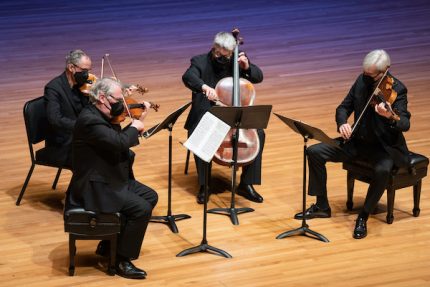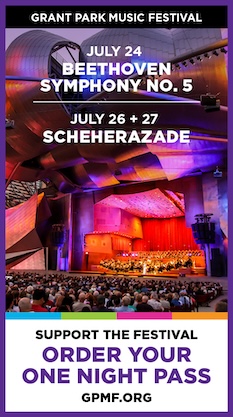Nearing the end of a 45-year run, the Emerson Quartet makes a final Chicago stop at DePaul

“Long through thy weary crowds I roam; / But now, proud world! I’m going home.” So wrote Ralph Waldo Emerson in his 1823 poem “Good-Bye,” his valediction to public life.
The Transcendentalist’s words may well be on the minds of the Emerson String Quartet, who announced recently that after more than 45 years, they would disband at the end of the 2022-23 season.
On Friday night at DePaul University’s Gannon Hall, in what was billed by the presenter as the Emerson Quartet’s final Chicago performance, the veteran ensemble offered a program of warhorses that appropriately traced the arc of the ensemble’s decorated career.
The program opened with Mendelssohn’s venturesome First String Quartet, one of the composer’s definitive entries in the genre and a work replete with youthful optimism. The Emersons took the opening movement at a sensibly bright tempo, ostensibly in a bid to eschew the score’s inherent sentimentality. The breezy style paired with an otherwise romantic approach to interpretation to unsatisfying effect. Throughout the Allegro non tardante, Eugene Drucker’s soaring first-violin melodies were marred by intonation issues.
The Allegretto, whose main melody is one of the work’s signature earworms, fared little better. A sluggish tempo at the start of the canzonetta made for a lumbering affair, and the virtuosic ripple of sixteenth notes that constitutes the movement’s central passage, while technically sound, suffered for clarity.
By the time the ensemble reached the Andante espressivo, the players had found their footing. An elegant and restrained account of the third movement’s fervent vocalise was followed by a vivacious delivery of the mercurial fourth, which made up for the lackluster showing in the second. Drucker, overcoming earlier flubs, took a lovely solo turn in the cascading first-violin theme that closes the work.
In Shostakovich’s String Quartet No. 9, the Emerson Quartet sidestepped the interpretative and technical pitfalls that beset the Mendelssohn. Written during one of the Stalin era’s brief artistic thaws and dedicated to his beloved third wife, the Ninth Quartet is reflective of the composer’s quieter twilight years yet still brims with his trademark icy orchestration and taut harmony.
The foursome took the opening Moderato con moto at a furtive pace, tracing plaintive melodies through the work’s gauzy textures before blossoming into nuanced, muted colors in the full-ensemble chords of the ensuing Adagio. A somewhat slackened tempo dulled the galloping third movement’s maniacal wit but was balanced by an exceptionally haunting fourth. The Emersons wove a sonic shroud from the Adagio’s haunting textures, and violinist Philip Setzer’s austere solo con sordino shone like an incandescent bulb through the fog.
The breakneck fourth movement proved the energetic zenith of the evening. Kudos are due in particular to cellist Paul Watkins — not only for his panache in the bristling solo that concludes the movement but for lending a burnished sound and sturdy rhythm that anchored much of this performance.
Beethoven’s Fifteenth String Quartet, the program’s linchpin work, was also the most resplendently performed. In the work’s collegial opening movement, the players sensitively defined the contrasting themes that unfold like old friends recounting their relationship. The second-movement minuet yielded sumptuous duet moments between Watkins and violist Lawrence Dutton.
Time stood still in the Emersons’ glorious reading of the expansive third movement, which Beethoven dedicated in thanksgiving to life itself. Pacing throughout was thoughtful and deliberate, and the sweet melody at the piece’s end, which sweeps down from violin down to cello before collapsing into intimately hushed tones, held the room in breathless silence. An amiable performance of the Fifteenth’s finale brought the audience to its feet in well-deserved extended applause.
Despite his promise of reclusion in “Good-Bye” (written when he was all of nineteen), the eponymous Emerson went on to more than a decade in the public eye and influential intellectual contributions. The members of the Emerson Quartet are relatively young, and each may still have several years ahead of them as individual performers and pedagogues. Despite this memorable benediction, chances are good this won’t be the last Chicago will see of these wonderful musicians — at least, let’s hope.
Posted in Performances
